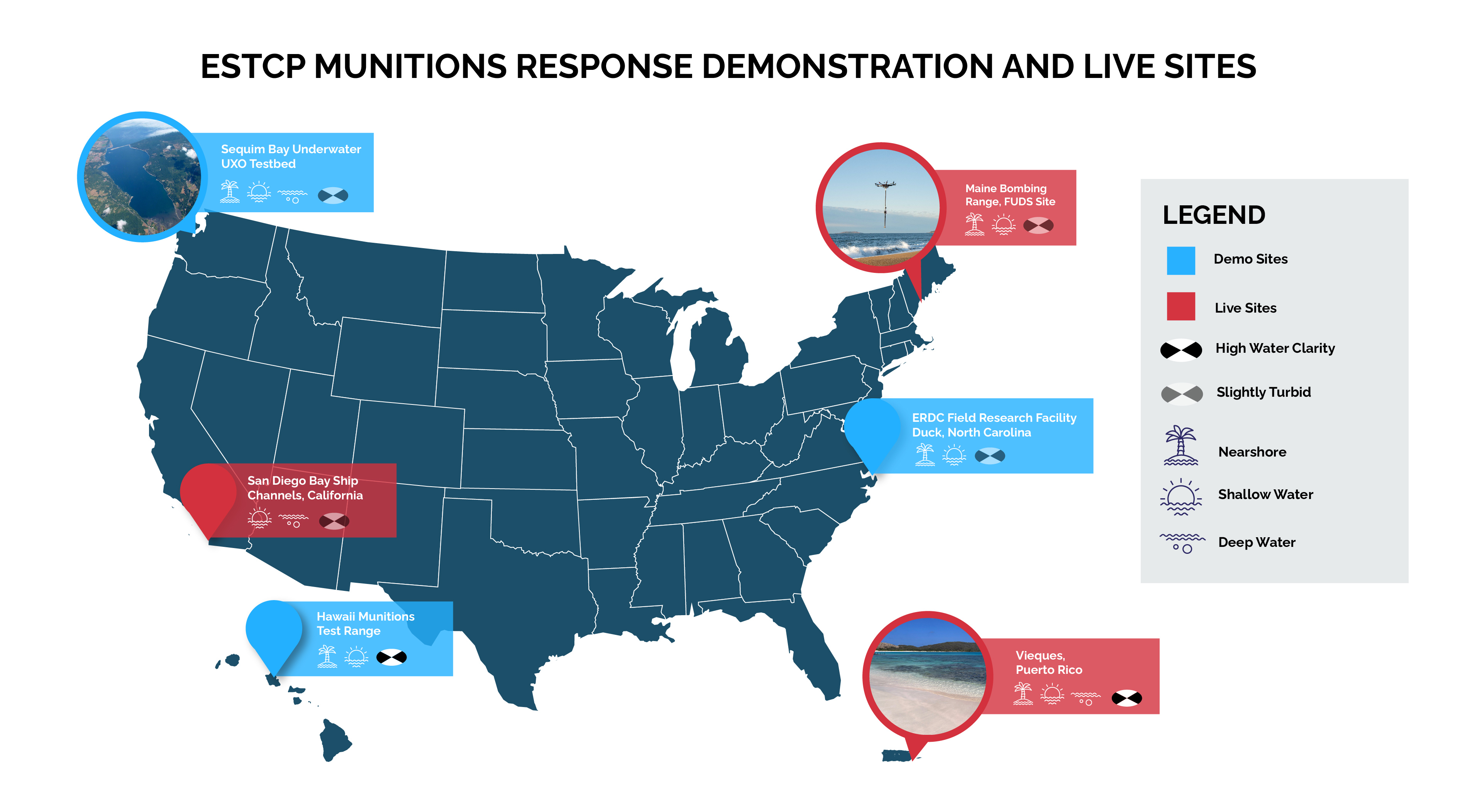Transition to Live Site Demonstrations
The program is shifting efforts to live site demonstrations, demonstrating technologies previously developed under ESTCP at real-world sites to optimize them for DoD and commercial use. Demonstrations will focus on evaluating system capabilities, limitations, developing sound operational concepts, and establishing quality metrics. This transition is in conjunction with the goals of DoD’s Advanced Geophysical Classification Accreditation Program (DAGCAP), Intergovernmental Data Quality Task Force (IDQTF), Interstate Technology Regulatory Council (ITRC), and DoD’s Environmental Data Quality Workgroup (EDQW) all of which aim to provide policy, guidelines, and a regulatory framework.

Demonstration Sites
UXO detection, classification, and localization (DCL) systems must be tested for potential geophysical circumstances expected in an underwater environment. UXO remediation at underwater sites presents unique challenges for DoD compared to terrestrial sites, because the underwater environment restricts access and impacts the performance of established and emerging DCL systems. The dynamic nature of sea conditions can also occasionally result in the mobility and repeated burial of munitions. ESTCP currently funds a small number of munitions response demonstration test sites to trial systems in a variety of underwater conditions prior to deploying in real-world scenarios:
- Pacific Northwest National Laboratory’s Sequim Bay Underwater Demonstration Site
- Located in Sequim, Washington, this site is well suited for surface ship towed systems due to its deeper water depths.
- University of Hawaii’s Hawaii Munitions Test Range Complex
- Located in O’ahu, Hawaii, this site is ideal for optical sensors due to its incredibly high water clarity.
- U.S Army Engineer Research and Development Center Coastal and Hydraulics Laboratory’s Field Research Facility
- Located in Duck, North Carolina, the dynamic weather, waves, currents, and tides at this site are ideal for testing technologies in a near-shore or shallow water environment.

Live Sites
Advanced UXO detection and identification technologies funded under the Munitions Response Program will be deployed at Navy and FUDS munitions response sites (MRS) to assess their performance under real-world conditions. The sites currently include Maine Bombing Area, San Diego Bay in California, and the former Vieques Naval Training Range (VNTR) in Puerto Rico. Each site offers unique conditions to test advanced metal detector and acoustic sensor capabilities. Conducting demonstrations at real munitions response sites is critical to ensure that innovative solutions are both effective and practical for addressing munitions response challenges while also meeting public safety needs.
- Maine Bombing Area (FUDS)
- This MRS is located in Georgetown Maine and is within the boundary of Reid State Park. Though identified as the “Maine Bombing Area” MRS, this area of this demonstration site was used only by single-engine fighter aircraft to practice firing rockets at targets floating in the water just offshore. This site is ideal for testing near shore and shallow water UXO detection technologies as it has a rapidly changing beach face and a dynamic surf zone.
- San Diego Bay (Navy)
- Located in San Diego Bay, California, the demonstration site is within the Primary Ship Channels, which is an active shipping channel in and out of the bay. The channels are subject to on-going dredging operations in areas suspected to have a wide range of munitions due to loss overboard and sunken ships. This is an ideal site to challenge underwater UXO detection technologies in a highly cluttered environment with difficult operating conditions.
- Vieques, Puerto Rico (Navy)
- Located on the eastern side of Vieques Island, Puerto Rico, the VNTR was utilized from 1941-2001 and has a wide range of munitions types. This site offers both deep and shallow water scenarios where the full portfolio of underwater technologies can be tested.

The UltraTEM marine towed system deployed at the Sequim Bay demonstration site for a blind shakedown test (2022).
